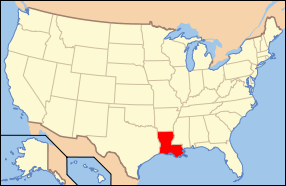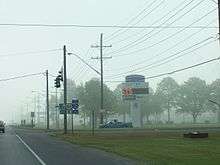LaPlace, Louisiana
| LaPlace | |
| Census-designated place | |
 U.S. Highway 61 (Airline Highway) at U.S. Highway 51 intersection in LaPlace | |
| Nickname: Andouille Capital of the World | |
| Country | United States |
|---|---|
| State | Louisiana |
| Parish | St. John the Baptist |
| Elevation | 10 ft (3.0 m) |
| Coordinates | 30°04′30″N 90°29′06″W / 30.07500°N 90.48500°WCoordinates: 30°04′30″N 90°29′06″W / 30.07500°N 90.48500°W |
| Area | 22.7 sq mi (58.8 km2) |
| - land | 21.5 sq mi (56 km2) |
| - water | 1.2 sq mi (3 km2), 5.29% |
| Population | 32,134 (2010) |
| Density | 1,287.8/sq mi (497.2/km2) |
| Timezone | CST (UTC-6) |
| - summer (DST) | CDT (UTC-5) |
| ZIP code | 70068 |
| Area code | 985 |
|
Location of La Place in Louisiana | |
 Location of Louisiana in the United States | |
LaPlace (pronunciation: /lə ˈplɑːs/) is a census-designated place (CDP) in St. John the Baptist Parish, Louisiana, United States, along the east bank of the Mississippi River in the New Orleans metropolitan area. The population is 32,134 at the 2010 census.
LaPlace is the southern terminus of Interstate 55, where it joins with Interstate 10, and of US 51, where it terminates at the junction with US 61. LaPlace is located 25 miles (40 km) west of New Orleans.
LaPlace's nickname is the "Andouille Capital of the World", referring to a variety of sausage.[1]
History
LaPlace was settled as a farming village in the 18th century during the French colonial era. It was named after early settler Basile Laplace.[2]
The city's railroad station was established in 1883.
LaPlace was the birthplace of early jazz musicians Kid Ory and Wellman Braud.
LaPlace has been designated "Andouille Capital of the World." An Andouille Festival is held every year in October. In his program "Feasting on Asphalt," TV chef Alton Brown visits LaPlace to sample its excellent sausage.
In early January 1811, a slave revolt began near LaPlace, known as the German Coast Uprising. This is said to have been the largest slave rebellion in U.S. history, with at least 200 and possibly as many as 500 insurgents.
It was larger than the revolt of 1836, which was more notorious; although there may have been many more slaves involved, overall, in the 1836 uprising and its ensuing three years of conflict. The revolt of 1836, known as the "Black Seminole Revolt" or Second Seminole War had an estimated number of 385 rebels at its height.
The difference is that the revolt of 1811 was ruthlessly put down by local white "militia" men within three days, and many of the rebel leaders and others were executed. The more extended rebellion of 1836 ended when the U.S. Army offered freedom to the holdouts, in exchange for a surrender. This was the only governmental emancipation of rebellious African American slaves in the antebellum era.
James H. Dormon, a University of Southwestern Louisiana professor of history and American studies, in a 1978 anthology, "Readings in Louisiana History"; wrote an article concerning the revolt of 1811, as did the late Thomas Marshall Thompson in the winter 1992 edition of Louisiana Historical Quarterly.
The Bonnet Carré Crevasse of 1871 occurred near LaPlace and resulted in severe flooding of New Orleans.
LaPlace is written with a capital letter in the middle of the word because Basile Laplace had a questionable background. A female member of the St. John the Baptist Parish Police Jury (the parish government) suggested a disassociation from him by using the spelling "LaPlace", which was agreed upon.
The Port of South Louisiana now maintains its headquarters in LaPlace.
Geography
LaPlace is located at 30°4′30″N 90°29′6″W / 30.07500°N 90.48500°W (30.075025, -90.484896)[3] and has an elevation of 10 feet (3.0 m)Template:GR3.
According to the United States Census Bureau, the CDP has a total area of 22.7 square miles (59 km2), of which, 21.5 square miles (56 km2) of it is land and 1.2 square miles (3.1 km2) of it (5.29%) is water.
Demographics
As of the census[4] of 2010, there were 29,872 people, 11,159 households, and 10,592 families residing in the CDP. The population density was 1,287.8 people per square mile (497.2/km²). There were 9,888 housing units at an average density of 460.0 per square mile (177.6/km²). The racial makeup of the CDP was 47.0% White, 47.9% African American, 0.4% Native American, 1.0% Asian, 0.1% Pacific Islander, 1.11% from other races, and 1.17% from two or more races. The cultural groups for Hispanic or Latino, of any race, were 6.1% of the population.
There were 9,171 households out of which 44.9% had children under the age of 18 living with them, 60.4% were married couples living together, 14.9% had a female householder with no husband present, and 20.0% were non-families. 16.4% of all households were made up of individuals and 4.9% had someone living alone who was 65 years of age or older. The average household size was 2.97 and the average family size was 3.34.

In the CDP the population was spread out with 31.2% under the age of 18, 9.4% from 18 to 24, 31.6% from 25 to 44, 21.3% from 45 to 64, and 6.5% who were 65 years of age or older. The median age was 32 years. For every 100 females, there were 96.6 males. For every 100 females age 18 and over, there were 93.8 males.
The median income for a household in the CDP was $45,103, and the median income for a family was $50,024. Males had a median income of $39,304 versus $23,277 for females. The per capita income for the CDP was $17,090. About 9.9% of families and 12.1% of the population were below the poverty line, including 15.4% of those under age 18 and 13.0% of those age 65 or over.
Education
St. John the Baptist Parish School Board operates public schools in the community. Some of the schools in LaPlace include Emily C. Watkins Elementary, LaPlace Elementary, Lake Pontchartrain, and John L. Ory. Three K-8 schools serve separate areas that have LaPlace addresses:[5]
- St. John Elementary School
- Ponchartrain Elementary School
- LaPlace Elementary School
Private schools
- Saint Charles Catholic High School, Riverside Academy, St. Joan of Arc, and Ascension of our Lord serve the community.
Appearances in film
LaPlace was used as a filming location in:
- The Oscar Award-winning movie Monster's Ball starring Halle Berry and Billy Bob Thornton.
- The television series Memphis Beat.
- Various scenes of WWE Studios movie Knucklehead.
- The IHOP scene from the movie Glory Road, which was filmed in the Old Airline Motors Diner on Airline Highway.
- The Jonas Brothers music video "Pom Poms", in which the Joe Keller Stadium was featured.
Other reading
- The African American History Alliance of Louisiana, published a book by Albert Thrasher, On to New Orleans! Louisiana’s Heroic 1811 Slave Revolt-1995.
Notable people
- A. J. Duhe, LSU alum, football player for Miami Dolphins
- Robert Faucheux, LaPlace attorney and state representative from 1996 to 2004[6]
- Randal Gaines, Louisiana state representative for St. Charles and St. John the Baptist parishes since 2012; LaPlace attorney
- Louis Lipps, football player for Pittsburgh Steelers and New Orleans Saints
- Chris Markey, football player for UCLA
- Damon Mason, Defensive Back and coach in the Arena Football League
- Nickie Monica, former parish president and former state representative; businessman in LaPlace
- Kid Ory, musician and bandleader
- DeQuincy Scott, football player
- Ian Villafana, guitarist
Hurricane Isaac (2012)
Seven thousand homes were flooded during Hurricane Isaac (2012). [7]
See also
| Wikimedia Commons has media related to LaPlace, Louisiana. |
References
- ↑ "SMOKED PORK PILGRIMAGE." NOLA.COM
- ↑ Louisiana Department of Culture, Recreation and Tourism. "LaPlace Historical Marker".
- ↑ "US Gazetteer files: 2010, 2000, and 1990". United States Census Bureau. 2011-02-12. Retrieved 2011-04-23.
- ↑ "American FactFinder". United States Census Bureau. Retrieved 2008-01-31.
- ↑ "Attendance Zones." St. John the Baptist Parish School Board.
- ↑ "Louisiana: Faucheux, Robert R. (Bobby)", Who's Who in American Politics, 2003-2004, 19th ed., Vol. 1 (Alabama-Montana) (Marquis Who's Who: New Providence, New Jersey, 2003), p. 778
- ↑ http://www.nola.com/hurricane/index.ssf/2012/09/hurricane_isaac_curfew_to_be_e.html
